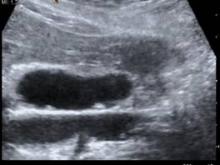A policy of regular ultrasound exams for small gallbladder polyps and resection on only larger ones could catch five more gallbladder cancers per year and save more than $200,000.
A retrospective study also found that 50% of gallbladder polyps were not followed at all, setting the stage for the rare – but potentially dangerous – cancers to develop, Dr. Giuseppe Garcea and his colleagues wrote in the Aug. 20 online issue of Archives of Surgery.
"All gallbladder polyps represent potentially premalignant disease and require discussion at a hepatobiliary multidisciplinary team meeting because this would enhance and standardize the management of this condition," wrote Dr. Garcea of the University Hospitals of Leicester (England).
The investigators reviewed the records of 986 patients with confirmed gallbladder polyps who were followed up for a median period of 39 months. The patients’ median age was 57 years.
About half of the polyps were detected by ultrasound after a complaint of upper abdominal pain, thought to have been caused by gallstones. The rest were found incidentally. Most of the findings were of single polyps (62%), but 24% of the lesions occurred in groups of three or more.
Specialist consultation was uncommon, with only 5% of cases discussed at a hepatobiliary multidisciplinary meeting. Half of the patients were not followed at all for changes in polyp morphology. Follow-up was more common in patients seen by a specialist than in those who were not (60% vs.10%).
Although 23% of the patients had an increased number of polyps over the follow-up period, only 7% of these lesions increased in size. Those polyps that did get larger were also significantly larger at presentation than those with a stable size (7 mm vs. 5 mm).
Surgery was performed on 134 patients. Histologic examination showed that in almost half of the gallbladders, the only abnormality was cholesterolosis or cholesterol polyps; 94% of the gallbladders had benign conditions. A malignant or potentially malignant pathology occurred in just five patients, with one polyp showing signs of malignant differentiation.
Polyps that were found to be malignant or potentially malignant during follow-up had also been significantly larger than nonmalignant polyps at presentation (median, 10 mm vs. 5 mm). All of the malignant polyps had also become larger during the follow-up period. A baseline size of more than 10 mm and increases in size during follow-up were the best predictors of malignant polyps (Arch. Surg. 2012 Aug. 20 [doi:10.1001/archsurg.2012.1948]).
Based on an incidence of 504 cases per 100,000 people in the United Kingdom, the authors pegged the annual socioeconomic cost of gallbladder surgery at about U.S. $78 million each year. They constructed a mathematical model assuming biannual ultrasound follow-up, and a 20-year expected life span after age at diagnosis. The model predicted that ultrasound surveillance would catch five patients with gallbladder cancer every year and save U.S. $507,986 per year in associated costs.
In the very young patients, however, "an argument may be made for prophylactic cholecystectomy even with polyps less than 10 mm, because the long protracted follow-up involved would be impractical and probably unsustainable," the investigators said.
To maximize effectiveness and financial gains, they determined that polyps sized 5-10 mm should be followed, and those larger than 10 mm should be removed. No study has determined the likelihood of a 5- to 10-mm polyp becoming malignant, they said, but because the risks associated with ultrasound surveillance and any subsequent gallbladder surgery are so small, they concluded that regular follow-up would still be cost effective.
Neither Dr. Garcea nor any of his coauthors reported any financial conflicts.



